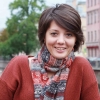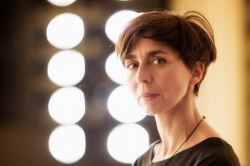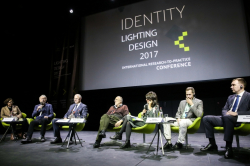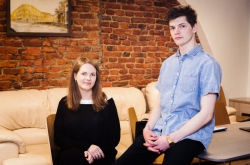The event was held as part of the “Week of Urban Planning, Architecture and Design” and moderated by ITMO University’s Higher School of Lighting Design. The week’s events are organized by the St. Petersburg Committee for Architecture and Urban Development and the St. Petersburg Committee for the State Inspection and Protection of Historic and Cultural Monuments. The discussion brought together representatives of St. Petersburg government and the industry, researchers and leading experts in the fields of lighting design, IT technologies, architecture and urban planning.
As Natalya Bystryantseva, head of ITMO’s Higher School of Lighting Design, International Research Laboratory of Lighting Design for Urban Environments and Institute of Art & Science, who served as the discussion’s moderator, noted, today St. Petersburg, which has always remained at the forefront of public lighting in Russia, faces the task of forming a new approach towards creating urban light environments.
“We have the important mission of working in lighting design and doing it together, using modern methods. After all, all that is happening right now in science and on the market should develop simultaneously, yet, unfortunately, too often these areas do not correspond to each other. Scientists talk of nanotechnologies, while the city’s utility services still have to solve routine issues that have little to do with cutting-edge technology. It’s as if they live in different worlds. For that reason, our common task is to decide how we can combine these areas and further develop our light environment. Lighting technology and even the approach to forming urban environments change every year. And it is of utmost importance for all of us to understand what light will mean tomorrow,” – she said at the event’s opening.

Information value is the top priority
For a long time, safety and comfort used to be the key factors in the formation of a light environment; the development of modern technology added information value to that list. Light is becoming a new means of communication between the environment and people, emphasized Prof. Bystryantseva. For instance, last year the Pushkin Museum of Fine Arts was the first cultural institution in Russia to support Panasonic’s Light ID technology that allows information to be read off of any object equipped with an LED light source.
In the recent years, scientists all over the world have been experimenting with the new technology that allows light transfer through light diodes in fluorescent lights. Paired with an optoelectronic sensor, a regular lamp turns into a modem. This technology is referred to as Li-Fi. Even today, some of the projects are applied outside of laboratories – in fall of 2016, it was announced that the world’s first Li-Fi-enabled office would open in Paris. In Russia, the country’s first light-based local data network was launched at ITMO University’s Department of Light Technologies and Optoelectronics. Even though the technology is unlikely to replace the “good old” Wi-Fi, analysts see great promise in light-based data transfer: the American research company Grand View Research predicts that by 2024, the light data transfer market will reach a $100 billion.
The opportunities offered by Li-Fi technology can have an effect not just on workplaces, but the entire urban environment, believes Igor Seredin, CEO of O2 Lighting Systems.
“Technology provides people with abilities they’d never had before and allows them to use space in a different manner. Nowadays, humans are given new ways to navigate the city, new sources of information about objects – for example, they can easily and quickly learn about the state of traffic, or anything else, for that matter. Before this, citizens could only do that at home, behind a computer, and now such possibilities are available anywhere in the city environment,” – he notes.

But how do we understand what the users themselves want to see their environment look like, and is it possible to predict which solutions would succeed and which would fail? The field of lighting design is gradually becoming a platform for collaboration between artists, architects, scientists and IT specialists. New tools that allow us to analyze peoples’ tastes and desires have a massive effect on the development of light environment – among other things. On the one hand, it is the analysis of massive amounts of data acquired from various sources that lets us find out what future guests would like to see; on the other, it is the ability to use various technologies, including VR, to model such spaces and avoid mistakes.
Light becomes art
However, it’s not just technology that determines the course for the development of light environment in new areas of developing cities. The interactivity of light objects, their focus on individuals and their new aesthetic perception – this is what today’s users desire, says Dmitry Burov, CEO of &light, an independent lighting architecture studio that works not only in Russia, but also in Argentina, the Philippines and other countries. As the expert noted, in just the last five years, the amount of requirements for projects on the global market has increased significantly: customers are enticed by the complexity of certain solutions. It’s no longer enough for a lighting design bureau or company to simply create a project – they must also figure out how it’ll be integrated into the surrounding environment and plan the “scenario” for the space they’re creating.

Dmitry Burov
“Practice shows that these days, customers desire complex, multi-faceted environments; they are no longer satisfied with local, limited solutions. The design requirements for elements, devices, are more demanding, too. Before this, you could see a sort of a utilitarian approach to things – elements were seen as simple light sources; now, they must always be aesthetically pleasing, be art objects on their own merit,” – comments Burov.
As the expert notes, urban or light environment is no longer perceived as something you see in the corner of your eye while driving a car; the light designers’ focus is shifting towards pedestrians, each of the individuals who, at any point in time, can start interacting with the environment and any of its objects. Due to this, a new perception of urban sculpture is appearing, adds Taras Mashtalir, media artist, composer and producer, ideologist of the SONICOLOGY project. Sculptures are no longer still, lifeless objects – quite the opposite, they are actively interacting with the observer. Just look at the projects developed by the famous Dutch media artist Daan Roosegaarde, whose works use light, sound and movement to come alive in response to people’s actions.
For instance, Studio Roosegaarde’s Lotus is a “living” dome made of hundreds of ultra-light aluminum flowers that open in reaction to human touch. When a viewer approaches the object, the silver dome lights up and stretches out its petals. Depending on the person’s actions, Lotus changes its behavior – from barely noticeable movement to a dynamic interaction. The interactions are based on the play of light and shadow, as well as sound effects that change in response to users’ actions.
However, such objects are fit not just for museums and exhibitions – they become organic parts of everyday urban environments. Take the Marbles project – another project by the studio – which has become an interactive playground for children.
In a similar manner, the sound sculpture Stella – a product of collaboration between Taras Maltashir, designers and architects from St. Petersburg Pavel Pankratov and Vladimir Antoschenko, and ITMO University – can also become a part of urban environment. The sculpture reacts to the slightest human touch and creates a harmonious sound accompanied by an array of colors. It has been exhibited, for instance, as part of the MediaIN festival in Alexandrinsky Theatre. As the media artist points out, Stella can take different forms, which will let it fit organically into St. Petersburg’s environment.

Light environment in St. Petersburg
But how, while taking into account the latest trends, do you create a complex new environment in what is a unique city-museum? In any project, the architecture and the rich cultural background which attract millions of tourists from all over the world to St. Petersburg have to be approached with extreme care, agree the representatives of the city government and the industry. Still, there are plenty of places in Russia’s cultural capital that require a new approach to light environment. The many residential areas, gardens and parks – this is where we can and must create unique areas that will bring together the people and their environment to create a new level of interactivity, says Sergey Mitelev, head of Lensvet (State unitary enterprise responsible for public and street lighting in St. Petersburg – Ed.)
The creation of such interactive spaces won’t be inhibited even by the weather, agrees Yuri Karpenko, head of Saros’s illumination engineering division. Successful projects are possible in northern areas: for example, just a couple years ago the Prismatica art installation – a bright constellation of 2 meters-high revolving prisms – was set up on the Place des Festivals in Montréal.
In order for such projects to serve as basis for the creation of a sophisticated light environment, it is necessary to create a chain of interactions for all members of the market, state authorities and research institutes, as well as to map out the required norms and regulations regarding the implementation of such initiatives, underlined Natalya Bystyantseva. One of the first steps in the creation of such a system will be the introduction of a common vocabulary for all of its participants and the strengthening of the relationship with bodies of state and with the Ministry of Construction, Housing and Utilities in particular, thinks Elena Belova, head of development at IntiLED.

Elena Belova
The discussion will continue during the Fourth International Research-to-Practice Conference Lighting Design 2017, which will take place on October 12 to 13 at Alexandrinsky Theatre’s New Stage. The event is an open, international discussion platform for representatives of science, business, arts and innovative technologies and will bring together more than 500 leading Russian and international experts in lighting design, architecture, arts, urban studies, engineering, IT and multimedia technology.
In addition, the results of the joint project for the development of a comprehensive program for the development of St. Petersburg by ITMO’s Higher School of Lighting Design and Lensvet will be presented there. This is Russia’s first city-scale project that includes the analysis of the light environment’s structure, predictions related to its development with regard to the increase in citizens’ quality of life and the prospects for the development of St. Petersburg’s energy sector. The results of this project will serve as basis for a targeted program for the development of public lighting in St. Petersburg for the period of 2018-2030 and up to 2050.






